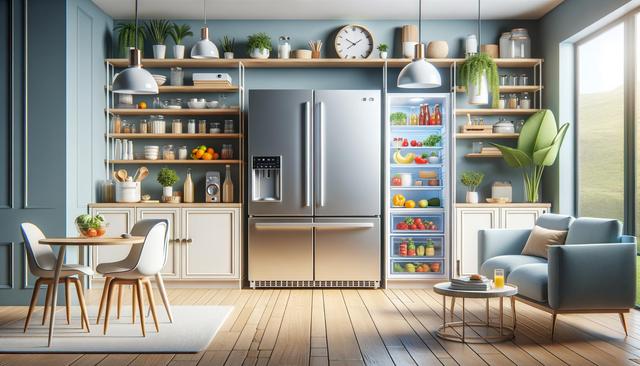Understanding Refrigerator Sizes and Dimensions
When shopping for a new refrigerator or freezer, one of the first aspects to consider is size. Understanding refrigerator sizes and dimensions is essential to ensure the appliance fits comfortably in your kitchen space while meeting your food storage needs. Standard refrigerator widths typically range from 24 to 36 inches, while depths and heights can vary based on the model and style. Measuring your available space accurately—taking into account door clearance, ventilation space, and room for opening drawers—is crucial. In addition to overall exterior size, consider the internal capacity, usually measured in cubic feet, to ensure it aligns with your household’s consumption habits.
Different types of fridges offer unique storage configurations:
- Top Freezer: Compact and generally more affordable, suitable for small households.
- Bottom Freezer: Easier access to fresh food at eye level.
- Side-by-Side: Equal space for fridge and freezer, convenient for families.
- French Door: Stylish with wide shelves, often with drawer freezers below.
Knowing these layouts can help in finding the best fit for small kitchens or larger open-plan spaces, depending on your layout and lifestyle.
Energy Efficiency in Modern Refrigerators
Energy efficiency plays a significant role in choosing a refrigerator or freezer, especially given rising energy costs and increasing environmental awareness. Modern appliances are designed to consume less electricity while offering improved performance. Looking for units certified for energy efficiency can lead to noticeable savings on your utility bills over time. Features such as inverter compressors, LED lighting, and improved insulation contribute to reduced power consumption. Understanding how these technologies work can help you make a more informed decision.
Here are a few tips to enhance energy efficiency:
- Choose models with automatic defrost and energy-saving modes.
- Keep your fridge well-stocked but not overcrowded to maintain temperature balance.
- Avoid placing hot food directly into the refrigerator to prevent overworking the compressor.
Energy efficiency in modern refrigerators is not just a cost-saving measure; it’s also a step toward more sustainable living, especially when upgrading from older models.
How to Choose the Right Refrigerator
Deciding how to choose the right refrigerator depends on several practical factors including household size, cooking habits, kitchen layout, and personal preferences. A single person or couple may find a compact model sufficient, while a large family might need a unit with expansive storage and multiple compartments. Storage flexibility, such as adjustable shelves and humidity-controlled drawers, can enhance usability for a variety of fresh and frozen goods.
It’s also important to evaluate the appliance’s design and finish. While it may seem cosmetic, the finish (matte, stainless steel, or textured) can impact cleaning ease and how well it matches your kitchen’s aesthetics. Integrated water dispensers and smart features like temperature control via apps are popular among tech-savvy users, but consider whether these features align with your actual needs and usage patterns.
Ultimately, the right refrigerator should complement your lifestyle by providing the functionality you use most, without overburdening your space or budget.
Top Rated Refrigerators With Freezer Integration
Many consumers prefer models that integrate both refrigerator and freezer compartments in a single unit due to their space-saving design and convenience. Top rated refrigerators with freezer integration offer optimized layouts for fresh and frozen storage, reducing the need for a separate chest or upright freezer. These models come in various configurations, including bottom freezer, top freezer, and French door styles, each offering different advantages depending on your usage habits.
These integrated units often include features such as:
- Dual temperature zones for better climate control.
- No-frost technology to eliminate manual defrosting.
- Multi-airflow systems for even cooling.
When evaluating options, look for user reviews and reliability ratings to gauge long-term performance and satisfaction. While integrated models are convenient, ensure they also meet your storage volume requirements, especially if you frequently freeze bulk items or prepare meals in advance.
Finding the Best Fit for Small Kitchens
Space limitations can make choosing the right fridge or freezer more challenging. Finding the best fit for small kitchens requires careful consideration of dimensions, design, and door swing direction. Compact models, such as counter-depth or under-counter refrigerators, can provide essential cooling and freezing capabilities without overwhelming the room. In galley kitchens or apartments, a slim-profile fridge with a top freezer might offer the right blend of utility and compactness.
Important considerations for small kitchens include:
- Reversible doors to accommodate left- or right-hand opening depending on layout.
- Flush or recessed handles to save space.
- Flexible storage solutions like slide-out shelves or door bins.
While smaller units may offer less storage, efficient organization can compensate for the reduced volume. It’s also helpful to look for models with quiet operation and vibration control, especially in open-plan living spaces where noise can be a concern.
Conclusion: Making an Informed Choice for Your Home
Choosing a fridge or freezer involves more than just picking a model that fits your kitchen—it’s about selecting an appliance that aligns with your lifestyle, habits, and sustainability goals. By focusing on factors like energy efficiency, size, layout, and integrated features, you can find a unit that enhances your daily routine while fitting seamlessly into your space. Whether you’re upgrading an old unit or furnishing a new home, understanding your options will help you make a smart, lasting investment.




Leave a Reply